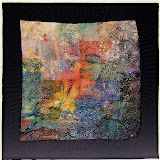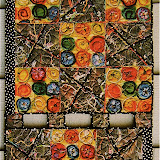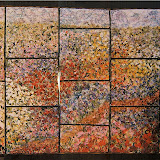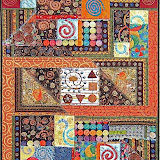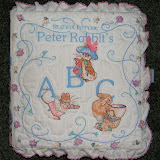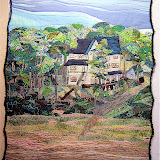Monday, July 28, 2008
Friday, July 25, 2008
The Back of the Mountain Lake Quilt
The fabric I chose for the backing is full of bears. One of the reasons is to represent my close encounters with black bears in our cabin. Go here and here to read about those.
The front of the piece is machine sewn and quilted. That was finished before I left the cottage in Michigan. All the handwork is done in the construction details on the back side. I've been working for days in one of my favorite spots ... along the Big Thompson river, the stream that runs past our cabin here in Colorado.


A double thickness fabric sleeve is made in two parts ... the method I use for all larger quilts so it can hang from the center as well as from the ends. Here you see the flat piece of wood with a drilled hole that the nail it will hang from will fit through. There are also holes drilled in each end so it will hang from three points.
Monday, July 21, 2008
On Top of the World
Thought I'd share some photos taken from Trail Ridge Road, the highway that crosses over the top of some of the Rockies highest peaks. It's the longest continuous highway in the United States that's over 12,ooo feet high.

There are resident herds of elk down in the valleys and even in town. However, most of them go up to the high country for the summer.
Friday, July 18, 2008
Rocks and Borders
Back to the mountain lake piece. The edges of the rocks had been left loose so the shrubby trees and flowers could be tucked between and behind them.
Here's a photo of the huge boulders along that lakes shoreline.


The borders were cut to size and the corners mitered. They were zig-zag stitched to the main part of the quilt. Various yarns are couched over the outside and inside edges over the border.
Now the not-so-fun part of hand-sewing facings and a sleeve to the back begins.
Monday, July 14, 2008
First Morning in the Mountains
This morning we awoke to this scene out of our bedroom window ...

Tuesday, July 08, 2008
Quilting the Lake
Determining a quilt pattern for the lake was the most difficult for me. I didn't wish to lose the wind wave patterns created by the crayon rubbing, but I could see no way to accent them. So, I just did ripple patterns. Now that it's finished, I see that the quilting does not obscure those crayoned patterns.



The scrubby trees and flowering weeds came next.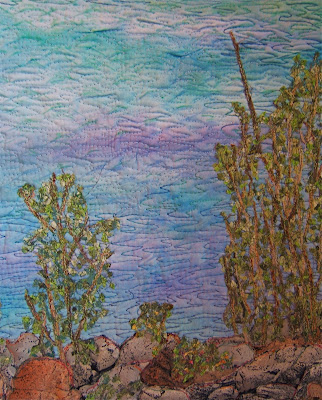
I wish to thank Anne for suggesting the tulle layer so that a minimum of quilting would suffice. It's amazing how difficult it is to see the tulle layer. The aqua color blends into the color of the lake between the foliage.
Next is the border.








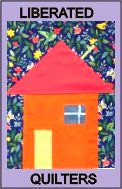 Fabric Bird Sculpture Pattern
Fabric Bird Sculpture Pattern




